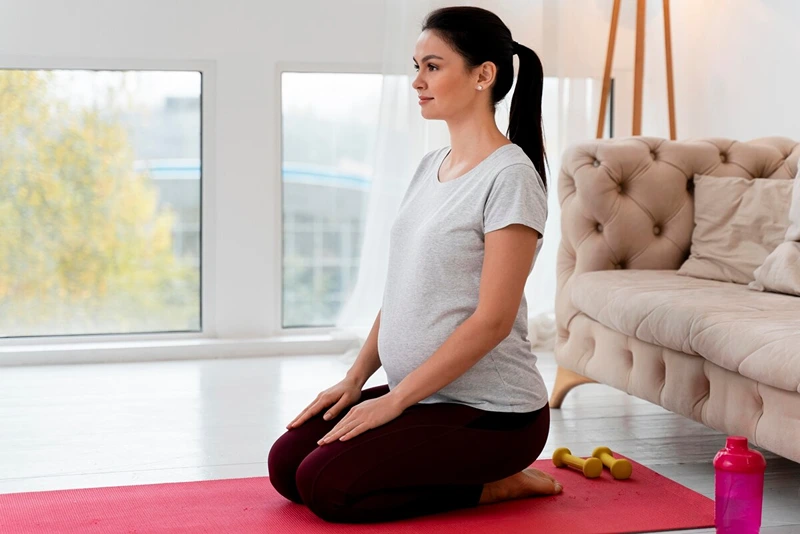After having a baby, your body undergoes significant changes, both physically and emotionally. Postpartum yoga, also known as postnatal yoga, emerges as a beacon of hope, offering numerous benefits to help mothers navigate this new phase of life. At Rac Women, we’ve delved deep into the myriad advantages of postpartum yoga to provide you with a comprehensive guide on its transformative power.
In This Article
The Science Behind Postpartum Yoga
Postpartum yoga is a modified, low-intensity yoga practice designed to cater to the unique needs of a mother’s body after childbirth. This form of yoga zeroes in on recovery and restoration, making it an ideal choice for new mothers.

Benefits of Postpartum Yoga
Postpartum yoga offers a plethora of benefits, especially during the first three months after childbirth:
| Benefit | Description |
|---|---|
| Increased Calmness | Helps in achieving a peaceful state of mind. |
| Decreased Anxiety | Reduces feelings of worry and unease. |
| Reduced Irritability | Helps in managing mood swings and anger. |
| Increased Energy | Boosts vitality and vigor. |
| Lower Blood Pressure | Aids in maintaining a healthy blood pressure level. |
| Reduced Muscle Tension | Relaxes muscles and reduces stiffness. |
| Relaxation through Meditation | Provides a calming effect on the mind. |
Yoga is a holistic practice that balances the emotional, mental, physical, and spiritual aspects of an individual. For new mothers, postpartum yoga can be a game-changer, enhancing mood, energy levels, and helping them reconnect with their bodies.
Alleviating Symptoms of Postpartum Depression
Childbirth can sometimes lead to postpartum depression, a condition that can manifest mild symptoms initially but can intensify over time. Symptoms include:
- Severe mood swings
- Uncontrollable crying
- Trouble bonding with the baby
- Withdrawal from family and friends
- Extreme fatigue
- Irritability and anger
- Anxiety
If you’re experiencing any of these symptoms, it’s essential to seek professional help. Postpartum yoga has been shown to alleviate these symptoms, offering a natural remedy to combat this condition.
Safety First: Getting Back into Yoga
It’s crucial to approach postpartum yoga with caution. While it’s tempting to dive right in, it’s essential to listen to your body and avoid overexertion. Postpartum yoga classes should involve modified poses tailored to the needs of new mothers. Especially during the initial weeks and months after childbirth, it’s vital to be gentle with your body.
Here’s a simple yoga flow to get started:
- Breathe in and connect with your body and mind.
- Take a deep breath into your belly and engage your core.
- Engage in the cat-cow pose to move your spine.
- Opt for the child’s pose to restore your abdomen and promote blood flow.
- Balance your nervous system with the Legs-Up-The-Wall pose.
- Conclude with a modified savasana pose for relaxation.
For those looking to bond with their newborns, practicing yoga with your baby can be a delightful experience. During the newborn stage, your baby will likely spend most of the class sleeping. These sessions can also provide an opportunity to socialize with other new moms, creating a supportive community.
Mindfulness and Recovery
Postpartum yoga is more than just a physical activity; it’s a journey of self-discovery and healing. Childbirth is a strenuous process, and postpartum yoga serves as a gentle bridge, guiding mothers towards a new, healthy normal.
Precautions for Postnatal Yoga
Before diving into the myriad benefits and practices of postnatal yoga, it’s paramount to understand the precautions associated with it. Doctors typically recommend waiting at least six weeks to start postnatal yoga after a normal delivery. For mothers who’ve had a C-section, this waiting period extends to at least three months.
Post-delivery, the abdominal muscles become sensitive. It’s always advisable to consult with your doctor before starting yoga. While yoga can be immensely beneficial, it’s essential to be gentle with your body, especially during the initial stages.

Benefits of Postnatal Yoga
Postnatal yoga offers a plethora of benefits, especially when practiced consistently and safely:
| Benefit | Description |
|---|---|
| Correct Poor Posture | Strengthen your core, straighten your back, shoulders, and neck. |
| Boost Energy Levels | Focus on breathing exercises to refresh and invigorate. |
| Manage Postnatal Depression | Build self-confidence and use deep breathing to calm and relax. |
| Improve Bladder Control | Strengthen and tone pelvic floor muscles for better bladder control. |
| Strengthen Abdominal Muscles | Tighten abdominal muscles and flatten the post-pregnancy tummy. |
| Prevent Backache | Stretch the spine and provide relief from backaches. |
| Improve Digestion | Practice specific yogasanas to improve digestion. |
| Yoga with Baby | Bond with your baby through gentle massages and poses. |
Postnatal Yoga Asanas for New Moms
For new moms eager to embark on their postnatal yoga journey, here are some asanas and tips to get started:
- Tadasana: Essential for posture correction.
- Vrikshasana: Tones leg muscles and enhances poise.
- Uttithapadasana: Tightens abdominal muscles.
- Bhujangasana, Paschimottanasana, Shalabhasana: Provide relief from backaches.
- Anuloma Viloma Pranayama: Beneficial for nerves and promotes balanced thinking.
- Shavasana: Recommended for relaxation.
Remember, always intersperse your asanas with Shavasana to prevent fatigue.
FAQs on Postpartum Yoga
Typically, after a normal delivery, it’s recommended to wait at least six weeks. If you had a C-section, you should wait for at least three months. Always consult with your doctor before starting.
Yes, certain poses might exert undue pressure on the abdominal region. It’s best to start with gentle poses and gradually transition to more advanced ones as your body heals.
Yoga, especially when combined with meditation, can help manage depression and anxiety in new moms. It aids in building self-confidence, and deep breathing exercises can induce a calming effect.
Ellen Crandall
Meet Ellen, your fitness compass in the world of athletics, training, and gym culture. With a commitment to well-being and a penchant for all things workout-related, Ellen is here to guide you on your journey to a healthier, fitter you. Join the fitness revolution, led by Ellen, and embrace the power of an active lifestyle.




